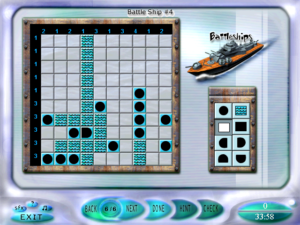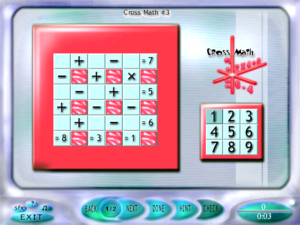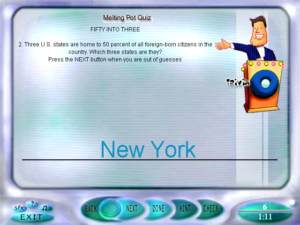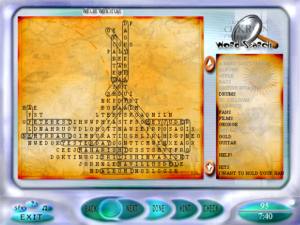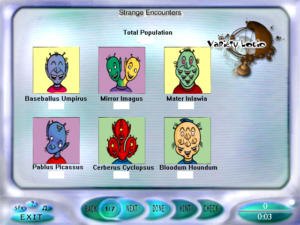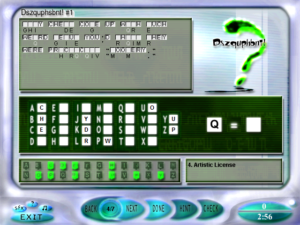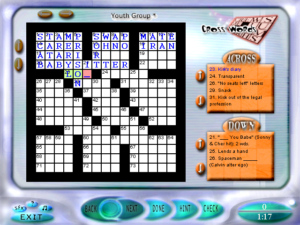Games Interactive 2: The Final Puzzle
OK, I finally convinced myself that the last Battleships puzzle really is impossible, and gave up on it. This decision hinged on the realization that the puzzle could be wrong without any errors in the row and column numbers. See, most Battleships puzzles start off with at least one tile already filled in, either with a ship piece or empty water, to eliminate ambiguity and guarantee unique solutions. (Annoyingly, the game lets you delete the pre-set tiles just like any tiles you’ve placed yourself, so you have to remember where they are so you don’t do that. The print version doesn’t have this problem.) This puzzle had one pre-set tile, a right-side endcap for a ship. When the game revealed the correct solution, sure enough: that endcap had been placed one space away from where it should have been. In retrospect, it’s a miracle that there weren’t more mistakes like this throughout the logic puzzles, given how many there are elsewhere.
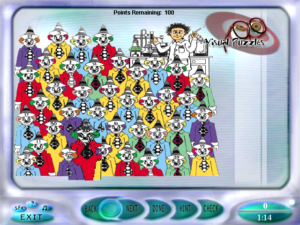 The remainder of the game went quickly. I finished the rest of the Trivia section, discovering as I did that one entire set of trivia questions had been accidentally put in twice under different names, then blasted through the Visual section in a sitting. Mainly it’s more of the visual puzzle types from the first game, this time with color added. In one case, the added color actually interferes with the puzzle: you’re asked to identify the one clown in a clown crowd that doesn’t match any of the others, and the clowns were colored without regard to whether they were supposed to match or not. But then, the scan was bad enough that it was more or less ruined anyway.
The remainder of the game went quickly. I finished the rest of the Trivia section, discovering as I did that one entire set of trivia questions had been accidentally put in twice under different names, then blasted through the Visual section in a sitting. Mainly it’s more of the visual puzzle types from the first game, this time with color added. In one case, the added color actually interferes with the puzzle: you’re asked to identify the one clown in a clown crowd that doesn’t match any of the others, and the clowns were colored without regard to whether they were supposed to match or not. But then, the scan was bad enough that it was more or less ruined anyway.
There’s a whole lot of puzzles where you have to type in phrases clued by cartoon images, and I’ll note that the typing interface here doesn’t have the problems it did in the Trivia section. There’s three of the sort where you have a line drawing overlaid on a grid, and have to find squares in the picture that match a set of clue squares. This was never all that hard a puzzle type, but the addition of color makes it downright trivial. Also, in the first game, I noticed that the clue squares, which were supposed to be in random orientations, were all in the same random orientation. It seems like they didn’t fix that. Probably they didn’t even notice it.
There’s one Cross Comics puzzle, where you have to arrange a bunch of comic panels into crossing but independent strips, like in Scott McCloud’s Choose Your Own Carl. The first game had one of these as well, although I didn’t describe it before. The UI for it there was terrible, and here it’s slightly less terrible — it’s a little easier to select panels — but still terrible in fundamentally the same ways. The basic problem is that the panels are displayed at a size that’s illegible at the game’s resolution. When you select a panel, a blown-up version is displayed on the right so you can actually read it. However, once you’ve selected a panel, you have to place it in the grid. You can’t even click on another unplaced panel to change your selection until you’ve placed the one you’ve selected. So you can’t read all the panels in advance, and it’s hard to check what you’ve already placed without accidentally rearranging it. Also, there’s one panel already placed, and you can’t select that one, which means you can’t read it. I can think of a simple change that would solve all of this: displaying the blow-up on rollover instead of click.
That done, all that remained was the final puzzle. I may well be the only person in the world to see it, other than the developers.
The main menu displays your options as green circles, and has one spot that looks like an empty depression where a green circle belongs. I had been assuming that this was where the button to access the final puzzle would appear when it was unlocked, but no. Instead, the final puzzle comes up automatically when you unlock it, and also every time you try to play any of the puzzles afterward. That’s right, unlocking the final puzzle locks you out of everything else. I can see a little sense to this: it’s a metapuzzle that’s intended to test your memory of the other puzzles. But you still can’t access the other puzzles after you’ve solved it, except by making a new profile.
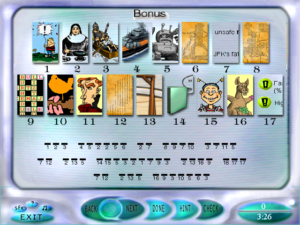 The way it works is: At the top of the screen, you get a bunch of pictures from the other puzzles in the game. The first letters of the names of those puzzles form the key to a cryptogram. Again this shows the designers’ ignorance of what they were making. To get to this point, the player has been through an entire section of cryptograms far harder than this one. The key is unnecessary.
The way it works is: At the top of the screen, you get a bunch of pictures from the other puzzles in the game. The first letters of the names of those puzzles form the key to a cryptogram. Again this shows the designers’ ignorance of what they were making. To get to this point, the player has been through an entire section of cryptograms far harder than this one. The key is unnecessary.
When you solve the cryptogram, and enter the correct answer, the game will tell you that it’s wrong. This is because their solution has the word “then” where it should have “than”. “Then” doesn’t even fit their own key. This is pretty much the perfect ending to the game, if you ask me. Just one last really obvious boneheaded mistake before saying goodbye.
It still hasn’t fully sunk in that it’s all finally over. This game is going to haunt me for a while. I knew before starting my posts that the the two games were buggy, but I didn’t realize just how bad it was going to be. But it feels good to have a record of it all. Perhaps it can serve as a warning.
 Comments(3)
Comments(3)